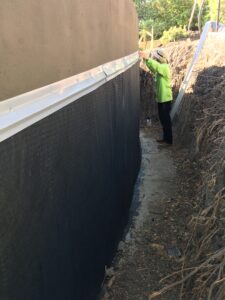Benefits of a Below-Grade Waterproofing System
Below-Grade Waterproofing is vital to protecting a commercial building’s foundation.
In case you don’t know, below-grade waterproofing refers to the application of protective materials, such as coatings, membranes, and accessories to a building’s foundation.
Examples of below-grade structures include underground parking lots, utility rooms, service tunnels, and elevator shafts.
Without choosing a high-quality, durable material to waterproof these structures, building owners will run into massive headaches down the line.
Why Below-Grade Waterproofing Systems so important?
A building’s foundation is made of concrete, which is a porous construction material.
Without adequately waterproofing the foundation, water can enter the concrete, causing cracks and putting the structural integrity of your building at risk.
More, suppose your building is located in contaminated soil.
In that case, whether it be methane gas, toxic groundwater, or other vapors, vulnerable, untreated concrete can allow these gases into itself, which poses a serious safety risk.
When below-grade waterproofing is done right, your foundation’s concrete stays safe, dry, and durable, keeping your building protected.
Now, let’s get into the types of below-grade waterproofing.
Fluid-Applied Below-Grade Waterproofing Systems:
Just as it sounds, a fluid-applied system is a liquid waterproofing system that is either sprayed or rolled onto a below-grade surface.
These systems come in many forms, including cold liquid-applied, hot liquid-applied, or single-component systems.
Sheet (Membrane) Applied Below-Grade Waterproofing Systems:
These systems come in pre-fabricated sheets and come in various materials: elastomeric sheets, modified bitumen, thermoplastic membranes, and sometimes bentonite.
When to use a membrane system vs. a fluid-applied system is entirely dependent on the needs of a building, and the details would require a whole article of its own!
Three Types of Below-Grade Waterproofing Systems Applications:
Now that we have covered the styles of waterproofing, let’s talk about application types.
When waterproofing a foundation, there are three main application methods: positive side, blindside, and negative side waterproofing.
Each application type depends on the job’s specifics and is decided by what is and isn’t possible.
Let’s get into it!
-
Positive-Side Waterproofing
This application is made on the outside of a building’s walls, which requires access to the wall after it has been constructed.
With positive-side waterproofing, the system is in direct contact with the water, which means that the system entirely prevents water from coming into contact with the building’s structural elements.
This makes positive-side waterproofing the ideal option.
Now, “ideal” is not always possible, which is why blindside and negative side waterproofing exist.
-
Blindside Waterproofing
Just like positive-side waterproofing, blindside waterproofing goes on the outside of the building, protecting the structural elements from water damage.
The twist?
Blindside waterproofing is installed before the walls!
While positive waterproofing attaches to the finished wall, blindside waterproofing comes first: quite literally, the building is built from the outside in!
Just as it sounds, blindside waterproofing is difficult, complicated, and only chosen when positive-side waterproofing is simply not feasible.
-
Negative-Side Waterproofing
This form of below-grade waterproofing is a last resort for developers.
As it sounds, negative-side waterproofing is applied to the inside of a building, which means that the waterproofing system itself is the last thing stopping water from entering the building.
Of course, negative-side waterproofing has another use: to protect older, already existing buildings.
In this case, it can be an excellent tool for repairing damaged basements and is an excellent way to keep leaks at bay.
Why Choosing a High-Quality System is Vital
Your below-grade structures are literally what your building stands on, and keeping them dry and durable is vital to your building’s health.
Truthfully, all of the benefits of a below-grade waterproofing system are better defined by what they prevent.
For example, one benefit of a high-quality system is that your foundation is much less likely to crack, which is a severe issue that brings costly repairs.
Another benefit of a high-quality below-grade system is that it blocks out moisture, making it an effective way to keep out dangerous mold and flooding to below-grade areas.
This also has another great plus for building owners; when your foundation takes in water, it starts to give off a foul odor, which makes occupying the building incredibly unpleasant!
Finally, when a building’s below-grade structures are exposed to water, bowing can occur, which can spell disastrous for a building’s structural integrity.
As you may have guessed, below-grade waterproofing is an excellent way to prevent this from happening.
How IPP’s Waterproofing Systems Keep Your Building Dry & Durable
At Instacoat Premium Products, we have developed a whole suite of waterproofing systems that are tailored to your below-grade needs.
To start, we offer multiple membrane systems.
To learn more about these systems and their benefits, click here:
As for fluid-applied systems, let’s talk about our Waterproofing system
This system is a superior fluid-applied rubber that combines the elastic properties of a modified latex with the weatherproofing and waterproofing qualities of a highly refined emulsified asphalt.
This system brings stellar benefits, such as:
Superior Elongation:
A traditional system offers elongation properties between 100-500%.
Our system has an elongation of 800% and a recovery of over 80%!
With traditional systems, a maximum recovery of 50% would be considered stellar, and many offer zero recovery at all!
Self-Repairing
We are proud to say that our system has one exceptionally unique feature: it’s self-sealing!
When punctured, our system self-seals.
When cut, our system self-heals!
Eco-Friendly
The IPP Waterproofing System is an environmentally conscious alternative to most conventional products.
It is:
- Water-based
- Cold fluid applied
- Requires no heat or special ventilation
- Contains no solvents and emits no VOCs
We Are Here to Help!
At IPP, we are always willing to help our customers choose which product is right for their building.
Reach out, and one of our experts will contact you ASAP!
(877) 552-6724
info@instacoat.com
Or, head to our “Contact Us” page of our website and leave a message.

